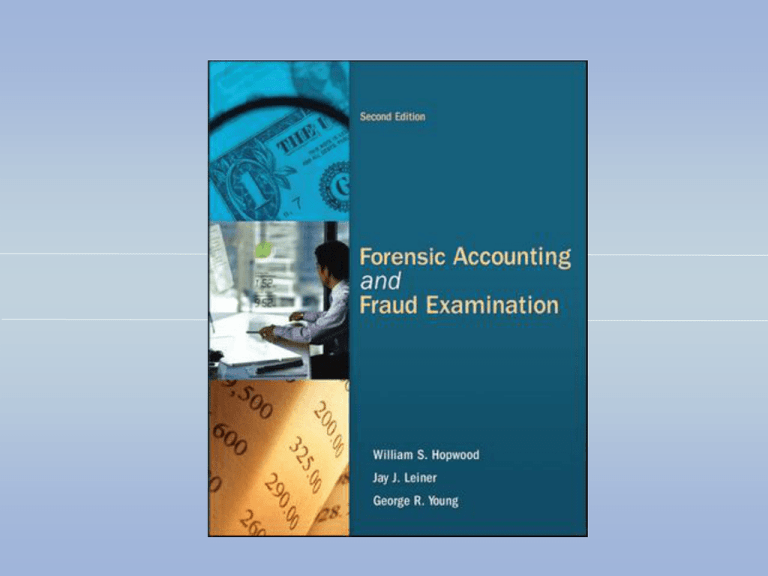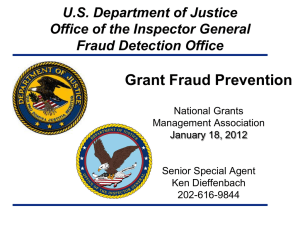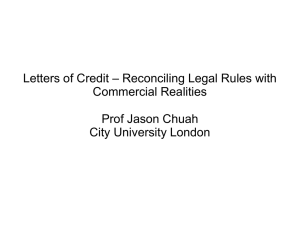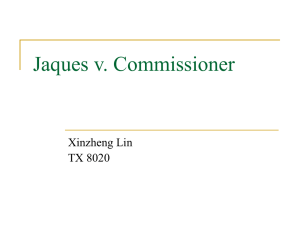
16-1
16-2
16
Tax Fraud
McGraw-Hill/Irwin
Copyright © 2012 by The McGraw-Hill Companies, Inc. All rights reserved.
16-3
What is Tax Fraud?
The
Tax Court, in Mandt v. Comm’r, TC Memo, 1955-226,
stated: Fraud connotes bad faith, a deliberate and calculated
intention at the time the returns in question were prepared and
filed, to defraud the Government of taxes legally due . . . [it
involves] the personal intent of the taxpayer, and intent being a
state of mind, seldom can one isolated act or omission be
singled out as evidencing a fraudulent intent. Such intent is to
be found by viewing a taxpayer’s entire course of conduct.
The
Internal Revenue Manual (IRM): “Tax fraud is often
defined as an intentional wrongdoing on the part of a taxpayer,
with the specific purpose of evading a tax known or believed to
be owing” and states that tax fraud requires both an
underpayment of tax and fraudulent intent.”
16-4
Indicia of Tax Fraud
To
determine whether fraud is present, the courts look for
objective manifestations of fraudulent intent called badges
or indicia, namely one or more acts of intentional
wrongdoing by the taxpayer with the specific purpose to
evade tax.
Affirmative
indications represent signs or symptoms of actions
that could have been performed for the purpose of deceiving
or concealing. Indications, by themselves, do not establish
that a particular process was performed with the intent to
defraud.
Affirmative acts are actions that provide evidence that a
process was deliberately done to deceive, undermine, or
conceal the true nature of events.
16-5
The IRS
The
largest of the 12 bureaus of the U.S. Treasury
Department.
Wage
and Investment Division
Small Business/Self-Employed Division
Large and Mid-Size Business Division (now named the
Large Business and International Division)
Tax-Exempt and Governmental Entities Division
Other divisions within the IRS include Appeals,
Communications and Liaison, and Criminal Investigation;
the latter handles criminal tax evasion cases.
The
Criminal Investigation (CI) Division Duties include
investigating possible violations of tax laws, money
laundering, and violations of the Bank Secrecy Act.
16-6
Types of Taxes and the Internal
Revenue Code
Individual
Income Tax
The U.S. individual income tax is a tax based on gross income such
as salaries and wages, interest and dividends, business income,
gains and losses (e.g., due to sales of real estate), and rental
income. The law allows adjustments to gross income for items such
as moving expenses, contributions to retirement accounts, and
alimony paid. Furthermore, the adjusted gross income (AGI) is
reduced either by a standard deduction based on filing status (e.g.,
single, married filing a joint return) or by deductions the taxpayer
itemizes such as mortgage interest, property taxes, charitable
deductions, and employee business expenses. The income tax
computed on the resulting taxable income is then reduced by credits
for items such as child care and foreign tax payments. Finally, the
tax after any credits is reduced by amounts already paid in the form
of withholding payments and estimated tax payments.
16-7
Types of Taxes and the Internal
Revenue Code
The
government imposes a corporate income tax. The
U.S. corporate income tax is a tax on the gross income of
corporations. The calculation of corporate taxable income
follows closely the calculation of pretax income shown in
corporate income statements.
Most states also impose an income tax on their citizens
or those doing business within their borders. The income
tax of most states is a flat rate tax that is based on the AGI
from the federal income tax return.
Most states levy a corporate income tax. This tax is
often called a franchise tax (in some cases, however, only
a state intangibles tax is labeled a franchise tax).
Most states impose sales and use taxes.
16-8
Types of Taxes and the Internal
Revenue Code
FICA
is assessed only when persons who qualify as
employees are paid (this tax, plus federal withholding, is
reported quarterly by employers on Form 941). are identical
to those that pertain to employees.
Federal unemployment taxes (Federal Unemployment Tax
Act, or FUTA) are filed on Form 940 and state
unemployment (State Unemployment Tax Act, or SUTA)
taxes are imposed on employers to pay for unemployment
benefits paid (or to be paid) to former employees who are
now unemployed. Payroll Tax Avoidance
Some employers have tried to avoid paying payroll taxes by
inappropriately classifying employees as self-employed
individuals.
16-9
The Internal Revenue Code
The
Internal Revenue Code (IRC) is contained in Title 26 of
the U.S. Code, which is divided into subtitles A through I. Each
subtitle is further divided into chapters. Chapters are further
divided into subchapters, which are further divided into parts.
When
we refer to specific code sections, normally we do
not state the title, subtitle, chapter, subchapter, and part. For
example, Title 26, Subtitle A, Chapter 1, Subchapter B, Part VI, §
179 is simply referred to as IRC § 179. However, any subsection,
paragraph, subparagraph, and clause are cited. For example,
IRC § 179 (b)(3)(B)(i) is read “Internal Revenue Code Section (or
simply “Section”) 179, subsection b, paragraph 3, subparagraph
B, clause i.”
16-10
Principal Tax Evasion Crimes
Principal crimes include willfully evading tax or willfully
failing to pay a tax (income tax as well as other taxes such
as estate, gift, and excise taxes), making false statements
on any return that is to be filed with the federal
government, or aiding in the preparation of fraudulent
tax returns.
Once a criminal tax investigation has begun, full payment
of taxes, penalties, and interest will not prevent
prosecution.
While the filing of an amended return is not considered an
admission of guilt with respect to a crime it can be used to
determine the amount of the underpayment.
16-11
Penalties in General
Conviction
of a felony tax offense usually results in the
assessment of a sentence and penalties. For example, the
following sentence and penalties are usually assessed for
each count of evasion (IRC § 7201):
Imprisonment
up to five years, fine of up to $250K, a civil
fraud penalty of 75 percent on the portion of the
underpayment due to fraud, costs of prosecution, and interest
on the underpayment
The
taxpayer is precluded from challenging the imposition
of the civil fraud penalty because the IRS met the higher
standard of proof required for criminal conviction.
Criminal prosecution normally takes place before civil
proceedings
16-12
Willful Attempt to Evade or
Defeat the Imposition of Tax
IRC § 7201 punishes willful attempts to evade or defeat any
tax imposed by the Internal Revenue Code or the payment
of the tax.
An
innocent spouse rule may help some spouses in joint
returns.
Three
elements of IRC § 7201 must be proven to sustain a
charge under this section: Substantial Tax Liability,
Attempt to Evade the Tax by an Affirmative Act, and
Willful Intent
Willfully Attempting to Evade
A
good faith misunderstanding of the law will prevent a finding
of willfulness.
16-13
IRC § 7202: Willfully Failing to
Collect or Remit Tax
IRC
§ 7202: any person who has a duty to collect, account
for, and remit any tax imposed by the Internal Revenue
Code and who willfully fails to do so is guilty of a felony.
Violations can be classified in the following two categories:
Willful
failure to collect the taxes.
Willful failure to account for these taxes and to remit them.
Instead
of being charged under IRC § 7202—which
requires proof of willfulness—taxpayers are more likely to
be charged under IRC § 7215 for either failing to collect,
account for truthfully, or remit taxes held in trust or for
failure to make deposits, payments, or file returns relating
to taxes held in trust.
16-14
IRC § 7203: Willfully Failing to Pay Tax,
File Return, or Supply Information
IRC
§ 7203: any person required by the Internal Revenue Code
to pay estimated tax or tax and who willfully fails to pay this
estimated tax or tax, file a return, keep records, or supply
requested information will, in addition to other penalties provided
by law, be guilty of misdemeanor.
IRC
§ 7203 specifies four punishable offenses:
Willful
failure to make (i.e., file) a return.
Willful failure to supply information.
Willful failure to pay tax and estimated tax.
Willful failure to maintain records.
To
be convicted, the taxpayer must have had a legal duty to
file a return for the taxable year for which she was charged and
willfully failed to file a timely return.
16-15
IRC § 7207: Delivering Fraudulent Returns,
Statements, or Other Documents
IRC
§ 7207: An offense to willfully deliver or disclose any
list, return, account, statement, or other document, that they
know to be fraudulent or false as to any material matter.
This statute is rarely used; its use has been limited to
prosecuting persons who alter cancelled checks and
invoices to support inflated deductions in circumstances in
which felony prosecutions are not warranted.
16-16
IRC § 7204, § 7204 : Employee
Withholding Statements
IRC
§ 7204: Typically provides punishments to employers
who don’t provide employees with, or provide employees
with false, W-2 or W-3 forms.
IRC § 7205(a) states that any individual required to furnish
an employer information about income tax withholding
violates that law if the employee willfully supplies false or
fraudulent information or willfully fails to supply the required
information and the failure results in the withholding of less
tax than had the true information been supplied (typically
applies to W-4 forms).
IRC § 7205(b): Provides for penalties for failure to a furnish
taxpayer identification numbers to banks and other payers
of interest and dividends.
16-17
IRC § 7206: Committing Fraud and
Making False Statements
IRC
§ 7206(1): An offense to willfully make (i.e., prepare and
file) and subscribe (e.g., sign) any return, statement, or other
document that contains or is verified by a written declaration that
it is made under penalties of perjury and that the person does
not believe to be true and correct as to every material matter.
For example, IRC § 7206(1) applies if the taxpayer
characterized illicit sales of drugs as sales of nutritional
supplements on an income tax return.
No tax deficiency is required for IRC § 7206(1).
Taxpayer can be charged with both IRC § 7201 and IRC §
7206(1) offenses.
IRC § 7206(2): Makes aiding and abetting preparation of a
false return illegal. The document doesn’t have to be made
under oath (as is the case under IRC § 7206(1)).
16-18
IRC § 7212(a): Interference
with Tax Laws
IRC
§ 7212(a): illegal to attempt to interfere with the
administration of internal revenue laws
Does
not require the person to be successful in interfering
Force—or even the explicit threat of force—is not required for
successful prosecution under this section.
IRC
§ 7212(a) has become a versatile weapon against tax
fraud. It does not require proof of a tax deficiency (as
required by IRC § 7201), the existence of a return or
document as required by IRC § 7206(1), or proof of a false
or fraudulent return or document as required by IRC §
7206(2)
IRC § 7212(a) even applies to improper rescuing of
property seized by the IRS
16-19
Termination and Jeopardy
Assessments of Income Tax
If
the IRS becomes aware that a taxpayer is likely either to
depart quickly from the United States, to remove his
property from the United States, in any way conceal himself
or his property from the authorities or becomes aware that
the taxpayer’s financial status is in peril, it can act to make
a jeopardy assessment according to IRC §§ 6861, 6862,
and 6867.
A termination assessment can be made by the IRS when it
believes the taxpayer might act to stop or interfere with the
collection of taxes for the current or immediately preceding
year. The tax becomes immediately due and the
assessment includes the tax as well any applicable interest.
16-20
Civil Tax Fraud
There
are typically more civil fraud convictions than criminal
fraud convictions because criminal cases require a higher
burden of proof (beyond a reasonable doubt)..
Innocent
Civil
errors can excuse liability.
Fraud Indicia and Evidence
Failure to file a return is only prima facie evidence of
negligence, but a long history of not filing could indicate
fraud.
In civil tax cases, the taxpayer does not have the burden to
disprove fraud. However, the taxpayer may present
evidence indicating that the civil fraud penalty should not be
applied.
16-21
Civil Fraud Penalties and Other
Penalties
The
civil fraud penalty of IRC § 6663 provides that if any
part of an underpayment of tax is due to fraud, a penalty of 75
percent of the part of the underpayment attributable to fraud will
be assessed.
If
the taxpayer fails to file a return, the penalty is normally 5
percent of the underpayment per month and is limited to a
maximum of 25 percent according to IRC § 6651(a)(1). If,
however, the failure to file is fraudulent, the penalty is 15 percent
for each month the failure exists up to a maximum of 75 percent
of the tax due (IRC § 6651(f)).
The
failure-to-pay penalty is applied to the balance of the
taxes that remain unpaid after the due date of the return.
16-22
Computation of Civil Fraud
Penalties
The
computation of the civil fraud penalty is determined
by multiplying the 75 percent penalty rate by the amount of the
tax underpayment that the taxpayer cannot prove was due to
innocent errors.
According to the regulations the formula specified for
calculating an income tax underpayment is:
U = W – (X + Y – Z), where
U = the amount of underpayment
W = the amount of tax imposed (i.e., the “correct” tax)
X = the amount of tax shown by the taxpayer on the return
Y = the amount not shown on the return but that was previously
assessed or collected without assessment
Z = the amount of any rebates made; IRC § 6664(a) defines
rebate as an abatement, credit, refund, or other repayment
16-23
STATUTE OF LIMITATIONS
Criminal Tax Prosecutions
IRC § 6531: Generally, a person cannot be tried or punished unless
indicted within three years of the offense. However, the period of
limitation is six years for certain offenses that include tax evasion.
For purposes of IRC § 7201, the statute of limitations begins to
run when the defendant engages in an affirmative act and has a
tax deficiency.
IRC § 6513(a) states that a return filed before the due date shall be
considered filed on the due date for that return. If an amended
return is filed to correct the filing of a false return, the statue begins
with the filing of the amended return, not the original return.
If the defendant is “outside the United States or is a fugitive from
justice” during any part of the statutory period of limitations, the time
he is outside the United States or a fugitive does not count as a part
of the statute (IRC § 6531).
16-24
Statute of Limitations
Assessment and Collection of Tax
According to IRC § 6501, the statute of limitations on the
assessment and collection of tax is generally three years.
If, however, the taxpayer filed a false or fraudulent return
with the intent to evade tax, willfully attempted to defeat or
evade tax, or failed to file a return, the government can
assess the tax or begin a proceeding in court for collection
of the tax at any time.
16-25
Methods of Proof
Direct
Methods
Point-of-Payment
Analysis
Point-of-Receipt Analysis
Indirect
Methods
There are three primary indirect methods: net worth,
expenditures, and bank deposits. These methods can be
used to show that the taxpayer’s estimated income is higher than
his reported income. These methods, however, cannot show the
source of the understatement. The “proof” provided by these
three methods is much like circumstantial evidence. In fraud
cases, it must be combined with other evidence to support the
assertion that the understatement of taxable income was due to
fraud.












